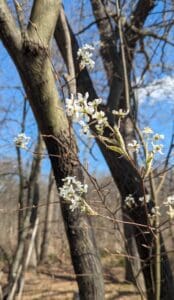By Jennifer Fairfield, owner The Garden Mill
(Publisher’s note: Part one of this column published yesterday.)

In the vegetable garden continued:
Early Blight can affect tomatoes, potatoes, eggplant, and peppers. Early blight generally first appears on the stem and leaves near the base of plants, as somewhat circular brown spots. As these spots enlarge, concentric rings appear, giving the areas a target-like appearance, often with a yellow halo. Eventually multiple spots on a single leaf will merge, causing the entire leaf to die.
Early blight can lead to a total loss of lower leaves and even the death of an infected plant. This disease thrives in hot, humid weather, but can be prevented by keeping plants somewhat thinned, and well-spaced, to allow for good air flow and faster drying of foliage. Copper-based fungicides can help to slow down the disease, but again, prevention is best, and begins with a regular application of fungicide from the time of planting.
Late Blight is a very destructive disease that mostly affects tomatoes and potatoes, but can also sometimes infect peppers and eggplant. Late blight begins as pale-green or olive-green areas that quickly enlarge to become brown-black, water-soaked, and oily-looking. Dark-brown to black areas can also appear on stems.
Affected parts of the plant develop a white-gray fuzzy appearance as the disease grows. This disease thrives in cool, wet conditions, and can kill a plant in a matter of days from the first appearance of symptoms. If late blight infects your plants, pull them immediately (removing all roots as well). Place all of the debris in a tightly closed plastic trash bag, set the bag in the sun for a few days to help kill the disease, and then dispose of it in the trash.
Late blight is a soil-born disease that can overwinter in plant material left in the soil, below the frost line, so leaving even the smallest amount of debris could mean you’ll be dealing with it the following year.
The best prevention for late blight is to plant disease-resistant varieties, rotate crops in the Solanaceae family (tomatoes, potatoes, peppers, eggplant) to different parts of the garden each year, and start a regular fungicide application at the time of planting.
Powdery Mildew is a disease that occurs on the leaves, branches, vines, and stems of many plants in the vegetable garden, including cucumbers, squash, beans, beets, eggplant, melons, carrots, lettuce, peas, pumpkins – you get the idea: pretty much everything.
Here’s an interesting thing though – every plant species has its own type of powdery mildew fungus, so the fungus that affects cucumbers is not the same one that affects lettuce, etc. Regardless of what plant is affected, symptoms typically start with a white, powdery-looking coating on the leaves of the plant (though tomatoes, peppers, and onions usually only show yellow patches). This disease thrives in hot, somewhat humid conditions, especially where air circulation is poor, and in shady spots of the garden.
Not to sound a like a broken record, but again, prevention is best. Spacing plants to allow good air flow, watering at the soil (as opposed to overhead), and applying fungicide on a regular schedule will help to keep the disease from taking hold. If you do end up with powdery mildew, Neem oil can help to eradicate it in early stages, but once your plants have a severe infection, there isn’t really anything you can do, but pull them – they won’t be producing much edible fruit at that point.
Downy Mildew, like powdery mildew, is a soil-borne disease that can affect many plants, but each plant family is only infected by a it’s own type of the disease. The plants most often affected in home gardens tend to be those in the cucurbit family (cucumbers, melons, squash, pumpkins, watermelon, and gourds).
Basil, grapes, hops, soybeans, and spinach are also susceptible to downy mildew. In cucurbits, it appears as green to yellow spots on the tops of leaves that later turn brown. The undersides of the leaves may show a gray fuzz.
Unfortunately, once this disease sets in, there is nothing you can do to stop it, and you should immediately pull the plants and dispose of them. Humid, wet conditions are perfect for downy mildew, and it has already been found here in Michigan this season. If you haven’t already begun a regular fungicide spraying program (neem oil and copper-based fungicides are generally the most effective for this disease), you should start now, to help slow down the progress of the disease in the state. Keeping plants well-spaced, and branches thinned and up, off the soil can help to deter the disease. I like to grow my cucumbers on trellises for that reason.
Cucumber Mosaic Disease is a virus that actually affects hundreds of different plants, including flowers, herbs, shrubs, and weeds. Symptoms, which vary by plant and plant development stage, can include stunting of entire plants, mosaic or mottling (blotchy light-and-dark-green or yellow-and-green areas) and ring spots (ring-like areas of discolored tissue) on leaves and fruits, along with a variety of growth distortions on leaves, such as cupping (or curling inward), puckering, and strapping (elongation and thinning). Severe infection can kill plants. This disease can overwinter in perennial shrubs, plants, and weeds, and is often transmitted to garden plants by aphids.
Planting disease-resistant varieties of crops, mulching well around your crops to prevent disease-carrying weeds, and controlling aphids with floating row covers in your garden are your best defenses against this disease. Insecticides sprayed on aphids are not very helpful, as by the time you see them on your plants, they have likely already spread the infection to your plants. Once your plants are infected, there is no cure.
Bean Common Mosaic Virus and Bean Common Mosaic Necrosis Virus are diseases that affect snap and dry beans. The viruses are often already in the bean seeds, so planting resistant varieties is important. Aphids can also transmit the disease. Plants grown from infected seed are almost always stunted and unproductive. Yields are generally not as affected in plants infected by aphids later in the growing season. Symptoms of both diseases include a light green or yellow and dark green mosaic pattern on leaves, often along with leaf puckering, distortion, or rolling. This disease has no cure, and there are no preventive measures, other than planting resistant varieties.
As with insect pests, there are many different diseases that could be affecting your plants – far more than I can cover here. I have tried to outline some of the most common ones we tend to see in Michigan gardens, but if you think your plants have a disease, and you can’t determine what it is, you can submit digital pictures to the MSU Extension Service’s Plant Diagnostic Lab for diagnosis, or mail or drop off samples of your plants for diagnosis. I can try to help with identification of disease, but it is not my area of expertise, and many diseases have similar symptoms, so I highly recommend turning to the experts on this.
Be sure to harvest cucumbers, beans, and zucchini regularly (I’m picking beans daily right now). Many plants will stop producing if you don’t keep harvesting. The reason for this is that they start to concentrate on maturing the fruits they have, in order to produce seeds. By constantly harvesting, you are basically tricking the plant into producing more fruit so that it can produce and mature seeds (that being the whole goal of the plant).
If you haven’t yet harvested your garlic, it’s probably getting to be time, as leaving it too long can cause it to rot in the ground – especially with how wet the ground has been. Get tips on harvesting, curing, and storing your garlic here.
Onions are also usually ready to harvest in July and August. Once those are out, you can put in some “succession” plants. Beets, radishes, lettuces, spinach, Swiss chard, kale, and peas all can be planted in August for harvest into the early fall. Take a look at the seed packet for the “days to maturity” to determine how late you can plant and still harvest before frost (and some things, like kale, are even better after a light frost). To figure out your safe planting timeframe, just count backwards from your average first date of frost (usually early October for our area, but you can get detailed information for your zip code here). So, if your packet says that the days to maturity is 45 and it takes 5 to 10 days to germinate, then you need to make sure that you have your seeds in by about Aug. 10.
It looks like (according to the latest weather forecasts) we are heading into a drier period than we’ve seen in a while, so make sure that you keep your garden watered. All that rain that we got in July doesn’t mean that your garden doesn’t need to continue to get at least an inch of water per week. When vegetable plants are at their peak of production, keeping them properly hydrated is key to making sure you get good quality harvests.
Raised beds and container plantings dry out even faster than in-ground gardens, so it’s really important to pay attention to soil moisture in those. When it’s hot and sunny, you may need to water raised beds and containers daily.
Keep your garden weed free by doing a little bit every day. The rain and heat we’ve had this summer are really helping the weeds proliferate. Don’t let them take over, or you may not get as good a harvest from your plants.
(Publisher’s note: Part 3 of this column will publish tomorrow.)














